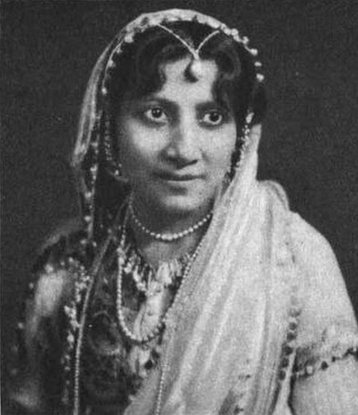
Atiya Fyzee
‐
Writer with an interest in Indian women’s lives
Other names
A. H. Fyzee
Atiya Fyzee-Rahamin
Atiya Begum
Shahinda
Place of birth
Date of arrival to Britain
Place of death
Karachi, Pakistan
Date of time spent in Britain
1906–7, 1908, 1914, perhaps mid-1920s, 1937–9
About
Born in Istanbul, Atiya Fyzee was the daughter of Hasanally Feyzhyder, an Indian merchant attached to the Ottoman Court, and his first wife, Amirunissa. Belonging to the prominent Tyabji clan of Bombay, Fyzee was one of the first elite Indian Muslim women to receive a modern education, appear in public unveiled and participate in women’s organizations. In her youth, she made important contributions to reformist journals for women in Urdu, including Tahzib un-niswan (Lahore) and Khatun (Aligarh).
While studying at a teachers’ training college in London in 1906–7, she also kept a travel diary that was first serialized in a monthly journal then published as Zamana-i-tahsil ('A Time of Education', 1921). Along with her sisters, Zehra (1866–1940) and Nazli Begum of Janjira (1874–1968), she patronized celebrated Muslim intellectuals such as Maulana Shibli Nomani and Mohammad Iqbal. Their published correspondence, Khutut-i Shibli ba-nam-i muhtarma Zahra Begum sahiba Faizi va ‘Atiya Begum sahiba Faizi (ed. Muhammad Amin Zuberi, 1930) and Iqbal (1947), attests to the close friendships that brought Fyzee notoriety in literary and social circles.
Following her marriage to the artist and writer Samuel Rahamin in 1912, Fyzee pursued a variety of cultural activities on the international stage. Among their collaborations was an authoritative book in English on classical Indian music that ultimately went into three editions: Indian Music (1914), The Music of India (1925) and Sangt of India (1942). In this work, Fyzee’s impressionistic and colourful prose was used to explicate Rahamin’s illustrations of Indian melodies (ragmalas). Fyzee also arranged music and choreography for two of her husband’s plays, Daughter of Ind and Invented Gods, when they were staged in London in the 1930s. While abroad, she gave lectures on Indian women, like ‘Epic Women of India’ (1919), which were published in international journals.
At partition, Atiya and Samuel migrated to Karachi with Nazli where they continued to bring together artistes in the private salon at their home, Aiwan-e-Riffat, modelled on their famous Bombay residence. After being evicted in the 1950s, they lived in reduced circumstances, suffering great hardship in their final years.
Shaikh Abdul Qadir, Abdullah Yusuf Ali, Syed Ali Bilgrami, Alma Latifi, Syed Ameer Ali, (Arthur) Oliver Villiers Russell Ampthill, M. A. Ansari, Thomas Walker Arnold, Badruddin Tyabji, the Maharaja and Maharani of Baroda, Emilie Barrington, Emma Josephine Beck, Mancherjee M. Bhownaggree, Mary Frances Billington, Lady Charlotte Elizabeth Blood, Hemangini Bonnerjee, Camruddin Abdul Latif, Vazirunnisa Latif, William Coldstream, Sunity Devi, Maharani of Cooch Behar, Sir Henry Cotton, Catherine Crisp, Frank Crisp, Major-General John Baillie Ballantyne Dickson, Princess Catherine Hilda Duleep Singh, Princess Sophia Alexandra Duleep Singh, Lady Alice Louisa Elliott, Sir Charles Alfred Elliott, Bhagwatsinghji Sagramsinhji, Thakur of Gondal, Mrs K. G. Gupta, Lala Har Dayal, Major Saiyid Hasan Bilgrami, Edward Hughes, Syed Husain Bilgrami, Mohammad Iqbal, Jabir Ali, Margaret Elizabeth Child-Villers, countess of Jersey, Jagatjit Singh, Maharaja of Kapurthala, Emily Kinnaird, Esther Lawrence, Dame Maude Agnes Lawrence, Sir William Lee-Warner, Sidney Low, Sir Charlies Lyall, Lady Florences Lyall, Miss A. J. Major, Mrs Sarala Bala Mitter, Theodore Morison, Nazli Begum of Janjira, Rafia Tyabji, Donald James Mackay, the eleventh Lord Reay, Lady Margaret Rice, George Frederick Samuel Robinson, first Marquess of Ripon, John Gerald Ritchie, Mrs P. K. Roy, Mrs P. L. Roy, Salman Tyabji, Sarhan Camruddin Latif, Mozelle Sassoon, Rachel Sassoon, Lady Edgeworth Leonora Scott, Lady Sinha, Cornelia Sorabji, Sydney Sprague, Navajbai Tata, Ratan Tata, Lady Mary Augusta Temple, Tyab Ali Akbar, Mary Augusta Ward, Helen Webb, Raymond West, Alice Augusta Woods, Sir (William Hutt) Curzon Wyllie.
Maria Grey Training College
Indian Music (London: Goupil Gallery and W. Marchant, 1914)
Zamana-i-tahsil (Agra: Matba‘ Mufid-i-‘Am, 1921)
The Music of India (London: Luzac, 1925)
Sangt of India (Bombay: n.p., 1942)
Iqbal (Bombay: Victory Printing Press, 1947)
Gardens (Karachi: Ameen Art Press, n.d.)
In English:
Lambert-Hurley, Siobhan and Sharma, Sunil, Atiya’s Journeys: A Muslim Woman from Colonial Bombay to Edwardian Britain (Delhi: Oxford University Press, 2010)
Justuju, Naeem-ur Rahman, ‘Portrait of a Lady’, http://www.pakistanlink.com/Letters/2003/June/13/04.html
In Urdu:
al-Qadri, Mahir, 'Atiya Faizi', in Yadgar-i-raftagan, vol. 2 (Lahore: al-Badr, 1984)
Jafri, Ra’is Ahmad, 'Atiya Begum Faizi', Nigar 58.5 (November 1979), pp. 25–7
Nasrullah, Shaikh, 'Atiya Begam Faizi', in Kya qafila jata hai (Karachi: Tahzib o Fan, 1984)
For image and copyright details, please click "More Information" in the Viewer.
Image credit
Atiya Fyzee Rahamin, 1921, no photographer credited
Public domain, via Wikimedia Commons, https://commons.wikimedia.org/wiki/File:AtiyaFyzeeRahamin1921.jpg
